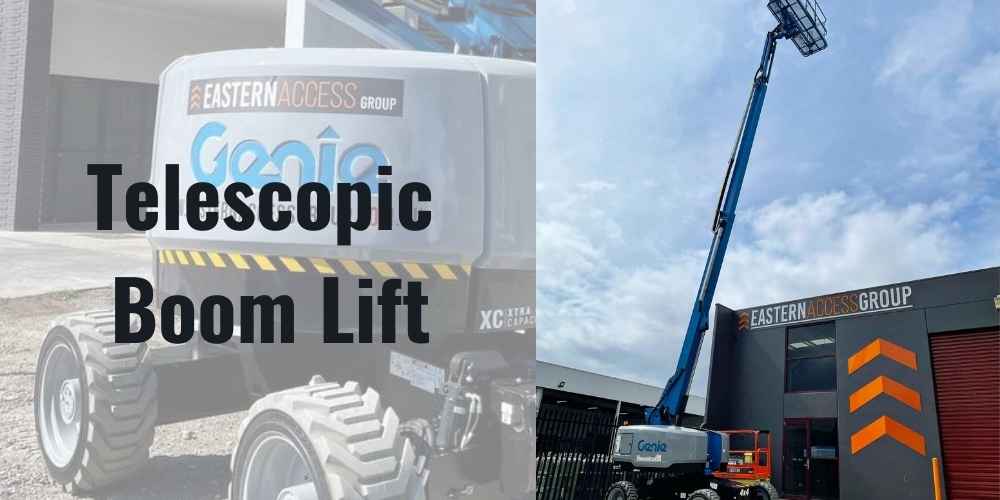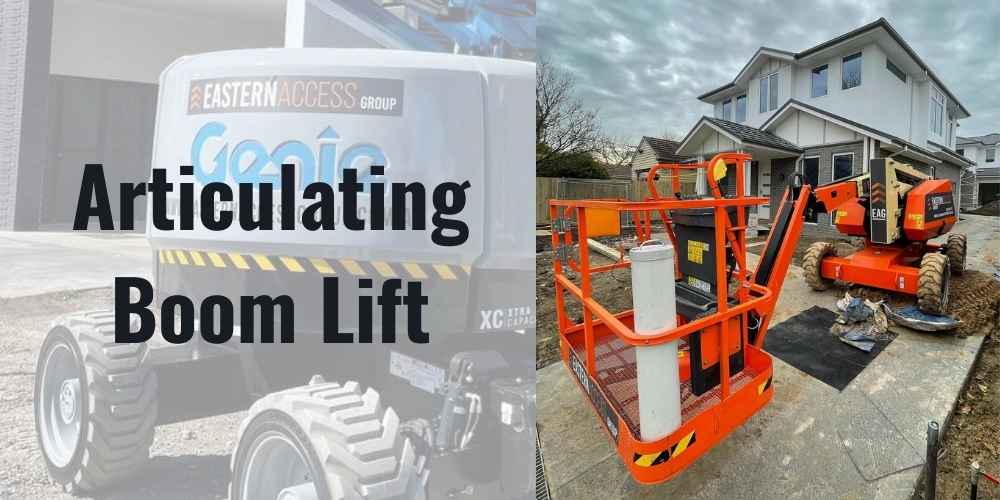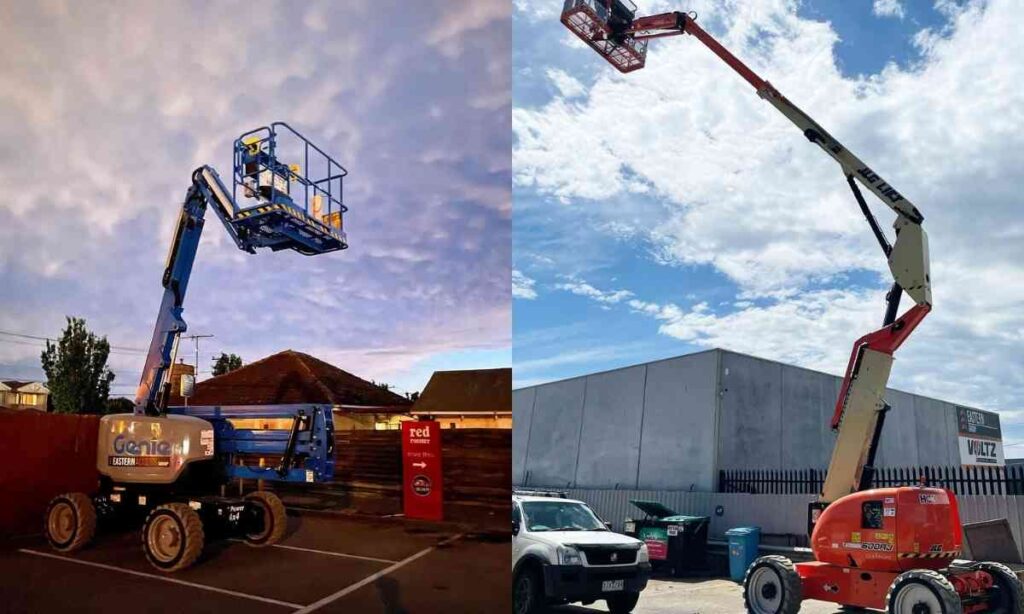Telescopic Boom Lifts VS Articulating Boom Lifts
Boom Lift’s History
Previously, the only way to reach new heights was to utilize a ladder or scaffolding. Scaffolding is difficult to erect and is not a good choice for a rapid project. Ladders do not provide the same work platform as standing and working and are better suited for climbing from one level to the next. Neither solution was ever the most secure or effective.
Table of Contents
A Canadian orchard worker invented the first boom lift while moving from tree to tree to pick fruit. His employees required a gadget that was both safer and more efficient than a ladder. Walter E. Thornton-Trump (nickname Ted) mounted a bucket on a wheeled platform at the end of a double-boom hydraulic arm. Ted’s Giraffe was born in 1951.
This invention gave rise to the phrase cherry picker. The new boom was connected to a tractor and towed by another machine. Ted came up with the first self-powered Giraffe five years later. This initial invention spawned 14 further lift models. Ted created each one with a unique purpose in mind, such as firefighting and orchard labor, among other things.
John L. Grove improved on Ted’s notion and went on to form JLG in 1973. John went on to patent 60 more boom lift designs, expanding the industry into construction and other labor-intensive industries. JLG unveiled the world’s biggest lift in 2015. The 185-foot boom, which can hold up to 1,000 pounds, might reach the same heights as a 17-story structure.
Boom lifts have since become commonplace in a variety of sectors. A lift is a piece of equipment for projects since it is a multi-purpose instrument that allows employees to reach new heights.
What is the Difference between Telescopic Boom Lifts and Articulating Boom Lifts?
Though using a boom lift may appear to be straightforward, knowing the differences in operationalized designs can make all the difference when completing a project. With two main variations on the market today, understanding their fundamental differences might save you a lot of money and time in the long run. Let’s take a look at the difference between a telescopic and an articulating boom lift.

Telescopic Boom Lift?
The telescopic boom lift, known as a straight boom, is a piece of high-access equipment with specialized features that are suitable for high-access jobs. Telescopic models can reach heights of more than 150 feet.
Outdoor projects sometimes require telescopic boom lifts because alternative high-access lifts may be hampered by uneven terrain or site obstructions. These machines can effectively stretch outwards and safely maneuver an operator in place, making them perfect for specialized operations.
The telescopic boom lifts are commonly used for maximum horizontal and vertical mobility and across projects which only require a single highly skilled operator. They have a vertical reach of 41 meters and a horizontal reach of 24 meters if you need to lift your head a little higher. Telescopic boom lifts are used for electrical repairs, tree trimming, small material haulage, and exterior finishing. Telescopic boom lifts increase productivity by allowing users to swiftly and conveniently get into the working posture as these come in sizes and capacities, making them ideal for outdoor construction.
Why choose a Telescopic Boom Lift?
Telescopic boom lifts have a long reach and enable rapid boom extension. Active oscillating axles and four-wheel drive are standard on telescopic booms, ensuring maximum terrain ability and traction. Depending on your needs, a telescopic boom lift can be equipped with either electric or diesel engines.
Key Features of a Telescopic Boom Lift
- Expanded horizontal reach
- It takes less time to achieve full height
- Oscillating axles provide maximum terrain capability
- Suitable for outdoor use
- Enhanced operational speed for specialized operations
- With a range of 30 feet to 100 feet plus

Articulating Boom Lift?
Another common type of high access equipment with particular characteristics built for specialized uses is the articulating boom lift, also known as the knuckle boom. The articulating boom lift has multiple joints that fold out to provide agility and flexibility. This boom lift type is manufactured in lesser sizes, but it can reach a height of 150 feet.
Indoor projects often require articulating boom lifts since other access lifts are unable to work around barriers and other constraints. The devices can operate in tight locations and in complex settings where access would otherwise be restricted or impossible. These are the most versatile lifting platforms with several operating configurations making them perfect for Several applications. As a result, articulating boom lifts have been used for water pipe and electrical repairs, exterior finishing, high-access cleaning, and general maintenance.
Why choose an Articulating Boom Lift?
If you need to reach between, over, or under multiple barriers while working at height, an articulated boom lift is the greatest machine unit for the job. Articulating boom lifts, in particular, enable operators to work in tight or congested areas where a telescopic boom lift would be impractical. They have both electric and diesel-powered versions. An electric articulating boom lift is environmentally beneficial because it emits no emissions and is noise-free, making for a more comfortable working environment for operators and noise-sensitive regions. They also have non-marking tires, which makes them ideal for interior operations. Construction and industrial companies often use diesel-powered articulated boom lifts because they can readily move about on tough terrain while maintaining a high level of stability.
Key Features of an Articulating Boom Lift
- Ideal for confined workspaces
- Increased maneuverability for overcoming obstacles
- For optimal interior use
- Can attain over and around 4WD traction that allows for a 40% grade
- A bendable jointed arm with a turntable
- 30 ft. to 100 ft. plus
Types of Articulating Boom Lifts
Electric Articulating Boom Lift
Electric articulating boom lifts allow you to be positioned every time with flexible, articulating jibs and operating heights ranging from 11.4m to 20.7m. The electric articulating boom lifts feature unique designs that are great for working on roof apexes or in places where a straight stick boom can’t reach.
The electric articulating boom lifts are suitable for smooth concrete surfaces and can be used indoors. These lifts have a long reach and are great for reaching areas that a standard scissor lift can’t reach. They include two joints that provide a great degree of flexibility. These articulated boom lifts are used in operations, including factory maintenance, shopfitting, and electrical work. These boom lifts are ideal for inside operations as they run on electricity and emit no harmful emissions. Additionally, the units can be charged if necessary. The electric articulating boom lift versions come in weights and can reach platform heights of up to 9.95 meters, 10.1 meters tall, 14.9 meters, and 13 meters. These characteristics make these units ideal for any interior maintenance work.
Rough Terrain Articulating Boom Lifts
Rough terrain articulating boom lifts are the industry’s workhorses, with unrivaled durability on rough terrain. The diesel and 4WD rough terrain boom lift hire have large access issues head-on, feeling right at home on any form of uneven ground and readily passing buildings or other obstructions, with working heights ranging from 11.8m to 43.15m.
Hybrid Articulating Boom Lifts
These are compact, low-weight design, innovative power-source technology, enhanced operator safety features, and versatile All Wheel Drive (AWD). These allow you to work in any industrial or construction area with rugged terrain, floor load constraints, or confined internal spaces.
Trailer Mounted Boom Lift
It makes it the smallest vehicle in its class, requiring only one parking place. As a result, the boom’s length has been decreased for better storage without reducing overall performance. As a result, it is more compact when towing and provides better access when operating both inside and outside. It can also be pulled by cars, including mid-size automobiles, because of its lightweight construction. It has an operating height of 12 meters and a lifting capacity of 200 kilograms. Its 4.5m horizontal extension makes it excellent for reaching high or difficult-to-reach regions. Furthermore, the 360-degree rotation allows for increased mobility flexibility on site.
It makes the cherry picker suitable for tasks such as signwriting, electrical work, painting, glazing, and facility maintenance. This unit is compatible with European and Australian regulations.
Boom Lift’s Frequently Asked Questions
What are the applications of boom lifts?
People and things are lifted into the air using boom lifts. It can also be utilized to manage obstacles and around corners, depending on the type of boom – telescoping or articulating. In contrast to a scissor lift, which is used to hoist, a boom lift is used to reach out and over.
What size of boom lift do I need?
Platform height and boom type are used to classify boom lifts. The height of the platform and whether a straight or articulating boom is more suited to the project location will decide the size of the boom lift.
Can boom lifts tip?
A boom lift, like any other heavy machine or vehicle, can tip. To guarantee that the equipment remains steady and safe at all times, an operator should constantly take adequate care and follow safety standards.
How long can I rent a boom lift for?
Boom lifts can be rented on a daily, weekly, monthly, or multi-month basis. Boom lifts can be rented for as little as a day or as long as you need them.
How much does it cost to rent a boom lift?
The cost of renting a boom lift varies based on the rental company, the location where the equipment is requested, and the period of the rental.
Conclusion
Remember to analyse your project to determine the type of boom lift best suits your specific job needs. Look for increased versatility, efficiency, and practicality in space restrictions and access height in the operational environment.

